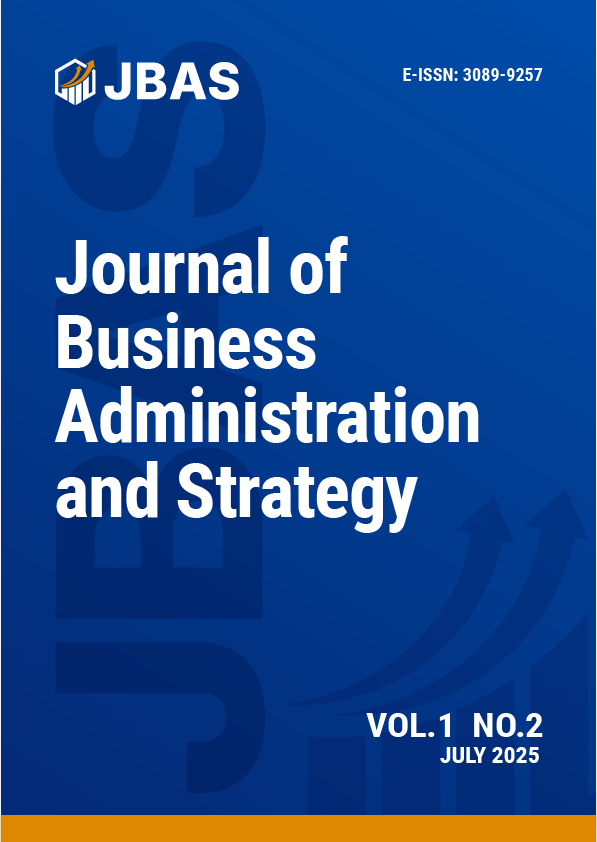Implementation of Situational Leadership Model in Improving Company Performance
Keywords:
Leadership Situational , Business Organization , Leadership Styles , Team EffectivenessAbstract
This research aimed to examine how the implementation of situational leadership models can improve work effectiveness in organizations. This research uses a descriptive qualitative approach with a library research method, which relies on various reference sources such as scientific journals, academic books, and previous research articles. The focus of the analysis is directed at understanding the leadership style applied by leaders in responding to the dynamics of employee readiness, as well as its impact on achieving organizational goals. The results showed that leaders who are able to adjust their leadership style according to the readiness level of their subordinates tend to be more successful in building productive work teams, increasing motivation, and creating a supportive work environment. The situational leadership model is also proven to be able to increase loyalty and collaboration within the team, and encourage sustainable human resource development. Thus, the implementation of situational leadership is the right strategy in optimizing workforce potential and supporting the achievement of organizational performance more effectively.
Downloads
References
Basuki, N. (2023). Mengoptimalkan modal manusia: Strategi manajemen sumber daya manusia yang efektif untuk pertumbuhan organisasi yang berkelanjutan. Komitmen: Jurnal Ilmiah Manajemen, 4(2), 182-192.
Blanchard, K. (1986). Kepemimpinan dan Manajer Satu Menit: Meningkatkan Efektivitas melalui Kepemimpinan Situasional. Jakarta: Erlangga
Gede, I. K., Hosea, E., Ratnaningsih, R., Hendriana, T. I., Hulu, D., Judijanto, L., ... & Wahyuni, N. N. T. (2024). Metodologi Penelitian Manajemen Bisnis: Teori dan Panduan Lengkap untuk Karya Ilmiah Terbaik. PT. Sonpedia Publishing Indonesia. Gunawan, Y. C. (2016). Gaya Kepemimpinan Situasional Pada PT Pramono Irindo
Jaya. Agora, 4(1), 314-323.
Hairiah, M., & Asy'ari, H. A. S. Y. I. M. (2024). Kajian Teori Sifat, Teori Perilaku Kepemimpinan Situasional dan Kepuasan Kerja: Studi Literature Review. Manajerial: Jurnal Inovasi Manajemen dan Supervisi Pendidikan, 4(4), 241-246.
Handoko, Y., Wijaya, H. A., & Lestari, A. (2024). Metode Penelitian Kualitatif Panduan Praktis untuk Penelitian Administrasi Pendidikan. PT. Sonpedia Publishing Indonesia.
Irma, E. R., Musnadi, S., Shabri, M., Yunus, M., Sakir, A., & Siregar, M. R. (2024). Kepemimpinan dan kinerja organisasi. Syiah Kuala University Press.
Kartono, Kartini. (2005). Pemimpin dan Kepemimpinan. Jakarta: PT. Raja Grafindo Persada.
Nyoman, M. N., & Wayan, A. I. (2021). Pemimpin Ujung Tombak Organisasi: The Leader of the Spearhead of the Organization. Arthaniti Studies, 2(1), 1-8.
Romadhoni, D., David, M. D., Taharuddin, T., & Nuriyanti, N. (2024). Tinjauan Literatur Tentang Dinamika Kepemimpinan Situasional Di Lingkungan Perguruan Tinggi Maritim. Jurnal Maritim Malahayati, 5(1), 175-182.
Sugiyono. (2013). Metode Penelitian Kuantitatif, Kualitatif, dan R&D. Bandung: CV. Alfabeta.
Wijaya, P. H., Widayati, C. C., & Rahmayanti, C. (2018). Pengaruh Gaya Kepemimpinan Situasional, Budaya Organisasi Dan Kompensasi Terhadap Kinerja. Jurnal ekonomi, 23(3), 319-333.
Downloads
Published
How to Cite
Issue
Section
License
Copyright (c) 2025 Laila Pitri, Fakhrur Rozi, Alfina Zsazsa Naqiya

This work is licensed under a Creative Commons Attribution-ShareAlike 4.0 International License.
All articles published in the Journal of Business Administration and Strategy are licensed under the Creative Commons Attribution-ShareAlike License (CC BY-SA). This license allows others to share, adapt, and build upon the work, even for commercial purposes, as long as they credit the original creation and license their new creations under the identical terms.
By submitting and publishing with the Journal of Business Administration and Strategy, authors agree to the following terms:
Ownership and Copyright
Authors retain copyright and grant the journal the right to first publication. The work will be simultaneously licensed under the Creative Commons Attribution-ShareAlike License (CC BY-SA), ensuring continued free and open access to the research.
Attribution Requirements
When reusing or redistributing the published material, proper attribution must include:
- Citation of the original article.
- Mention of the journal name and publication date.
- A link to the published work and the license details.
ShareAlike Terms
Any derivative works based on the original must be distributed under the same license (CC BY-SA).
Open Access
The Journal of Business Administration and Strategy is dedicated to open access, providing free and unrestricted access to all published articles without subscription fees or other access barriers.
Author Warranties
By submitting the manuscript, authors warrant that:
- The work is original and has not been published elsewhere.
- All co-authors consent to publication.
- The work does not infringe on any copyright, trademark, or proprietary rights.
No Additional Restrictions
Authors and readers are not permitted to impose legal terms or technological measures that legally restrict others from doing anything the license permits.








